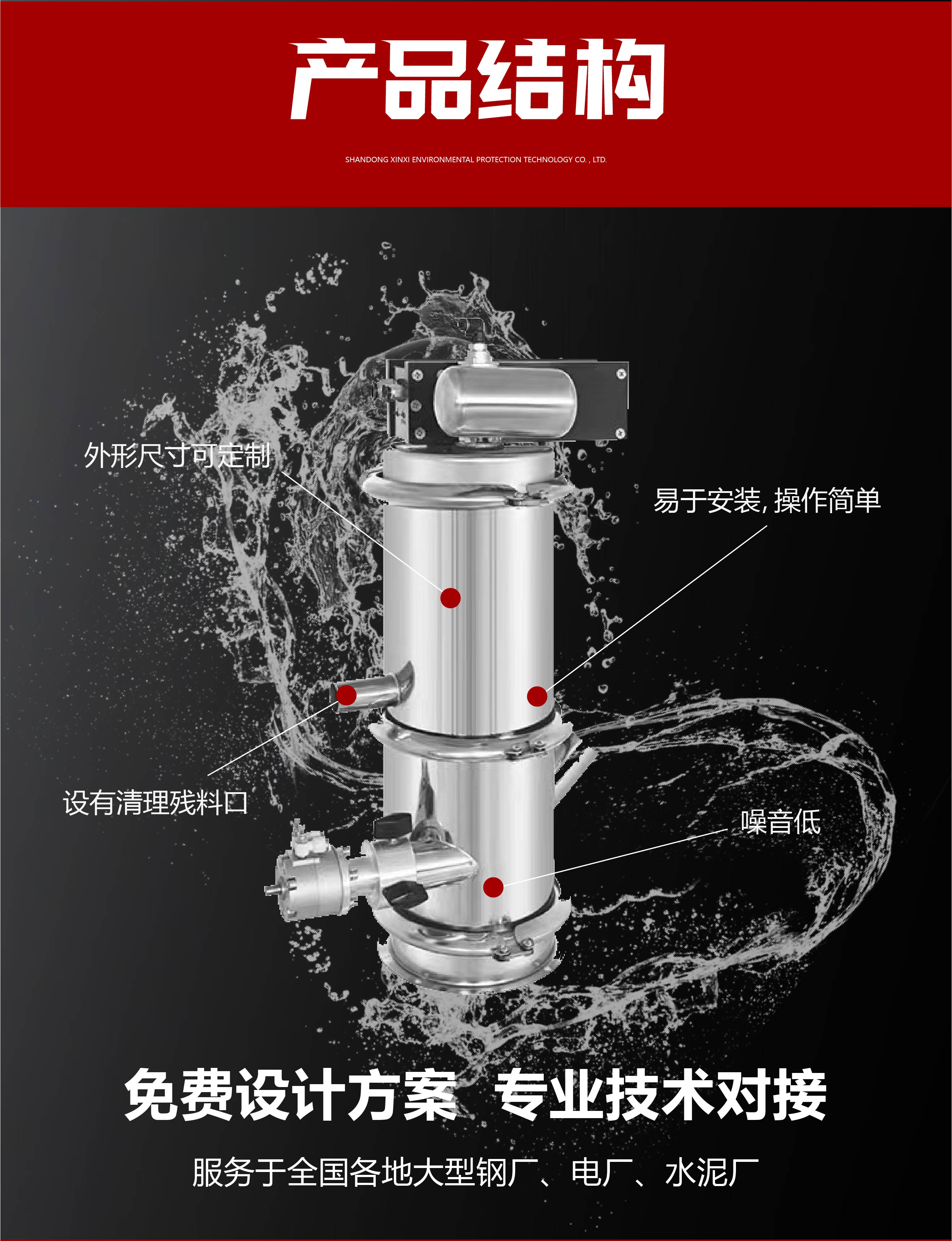 濟(jì)南鑫魯泉盛機(jī)械設(shè)備有限公司
濟(jì)南鑫魯泉盛機(jī)械設(shè)備有限公司
服務(wù)熱線:15662735099
聯(lián)系地址:山東章丘棗園經(jīng)濟(jì)開(kāi)發(fā)區(qū)
在工業(yè)氣力輸送系統(tǒng)中
In industrial pneumatic conveying systems, the bin pump is like a "strongman" carrying heavy loads, constantly enduring the test of internal pressure. Once the pressure gets out of control, it will not only affect the delivery efficiency, but may also bring safety hazards. The intelligent pressure release technology of the warehouse pump is like the "pressure safety valve" equipped for this "strongman", which uses intelligent means to accurately regulate pressure, safeguard equipment safety and system stability.
倉(cāng)泵在工作過(guò)程中
During the operation of the warehouse pump, the internal pressure is dynamically affected by various factors such as material conveying volume, pipeline resistance, and intake flow rate. The traditional pressure release method relies on manual monitoring and mechanical valve control, with delayed response and difficulty in precise adjustment. Intelligent pressure release technology introduces advanced sensors and control systems, building a sharp "perception analysis execution" system. Pressure sensors are like the "nerve endings" of a chamber pump, monitoring internal pressure changes in real time and transmitting data to the control system at millisecond speeds. When the pressure value approaches the preset safety threshold, the control system immediately starts the analysis program, combines historical data with current working conditions, judges the pressure change trend, accurately calculates the required pressure release amount and release timing, and avoids pressure risks caused by energy waste or insufficient release due to excessive release.

智能壓力釋放技術(shù)的執(zhí)行環(huán)節(jié)充滿(mǎn)科技巧思。不同于傳統(tǒng)機(jī)械閥門(mén)的粗放操作
The execution process of intelligent stress relief technology is full of technological ingenuity. Unlike the extensive operation of traditional mechanical valves, intelligent release devices use electric or pneumatic regulating valves with high-precision adjustment capabilities. When the control system issues a command, the regulating valve can quickly and accurately adjust the opening, achieving a smooth release of pressure. For example, during the unloading stage of the warehouse pump, if the internal pressure suddenly rises due to pipeline blockage, the intelligent regulating valve can be opened in stages and small amplitudes based on the calculation results, gradually reducing the pressure and preventing material backflow or pipeline vibration caused by excessive pressure release in an instant. At the same time, during the release process, the system continuously monitors pressure changes and dynamically adjusts the opening of the regulating valve to ensure that the pressure is always maintained within a safe range, just like an experienced driver who precisely controls the speed of the vehicle in complex road conditions.
除了精準(zhǔn)調(diào)控壓力
In addition to precise pressure regulation, intelligent pressure release technology also has strong adaptive capabilities. The industrial production conditions are complex and varied, and different material characteristics, conveying distances, and environmental conditions can all affect the pressure of the warehouse pump. The intelligent system continuously accumulates pressure change data and optimal release strategies under different working conditions through machine learning algorithms. When encountering new working conditions, the system can quickly call up empirical data from similar scenarios and automatically optimize the pressure release plan based on the current actual situation. For example, when conveying materials with high viscosity, the system can predict the upward trend of pressure in advance, actively adjust the release parameters, and prevent excessive pressure; In low temperature environments during winter, considering the impact of gas density changes on pressure, intelligent systems can also respond in a timely manner to ensure the effectiveness of pressure release.
智能壓力釋放技術(shù)還為設(shè)備管理帶來(lái)便利
。通過(guò)與工業(yè)物聯(lián)網(wǎng)平臺(tái)連接,管理人員可遠(yuǎn)程實(shí)時(shí)查看倉(cāng)泵壓力狀態(tài)與釋放記錄,實(shí)現(xiàn)對(duì)設(shè)備的全方位監(jiān)控。系統(tǒng)內(nèi)置的故障診斷功能,能夠?qū)毫Ξ惓2▌?dòng)、釋放裝置故障等問(wèn)題進(jìn)行預(yù)警,并提供詳細(xì)的故障分析報(bào)告,幫助維修人員快速定位問(wèn)題、解決故障。此外,智能系統(tǒng)還能對(duì)壓力釋放數(shù)據(jù)進(jìn)行深度分析,為優(yōu)化輸送工藝、改進(jìn)設(shè)備設(shè)計(jì)提供數(shù)據(jù)支持。例如,通過(guò)分析不同時(shí)段的壓力釋放頻率與幅度,找出輸送過(guò)程中的瓶頸環(huán)節(jié),針對(duì)性地調(diào)整進(jìn)氣策略或優(yōu)化管道布局,提升整個(gè)氣力輸送系統(tǒng)的運(yùn)行效率。Intelligent pressure relief technology also brings convenience to device management. By connecting with the industrial Internet of Things platform, management personnel can remotely and real-time view the pressure status and release records of the warehouse pump, achieving comprehensive monitoring of the equipment. The built-in fault diagnosis function of the system can provide early warnings for abnormal pressure fluctuations, release device failures, and other issues, and provide detailed fault analysis reports to help maintenance personnel quickly locate and solve problems. In addition, the intelligent system can conduct in-depth analysis of pressure release data, providing data support for optimizing conveying processes and improving equipment design. For example, by analyzing the frequency and amplitude of pressure release at different time periods, bottleneck links in the conveying process can be identified, and the intake strategy or pipeline layout can be adjusted accordingly to improve the operational efficiency of the entire pneumatic conveying system.
本文由倉(cāng)泵友情奉獻(xiàn).更多有關(guān)的知識(shí)請(qǐng)點(diǎn)擊:http://m.513951.com/我們將會(huì)對(duì)您提出的疑問(wèn)進(jìn)行詳細(xì)的解答,歡迎您登錄網(wǎng)站留言.
This article is dedicated to friendship For more information, please click: We will provide detailed answers to your questions. You are welcome to log in to our website and leave a message
2024 濟(jì)南鑫魯泉盛機(jī)械設(shè)備有限公司 備案號(hào):魯ICP備18012408號(hào)-3 魯公網(wǎng)安備37018102000806號(hào)

